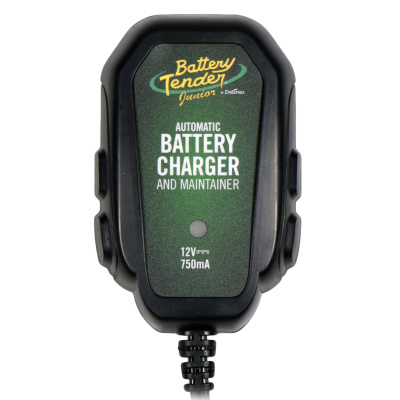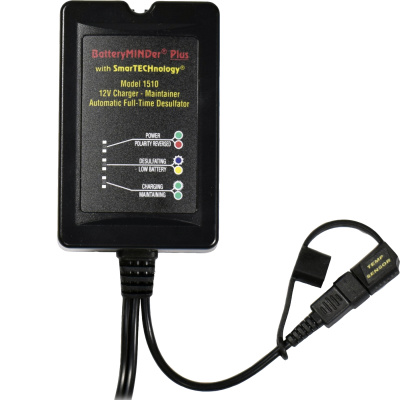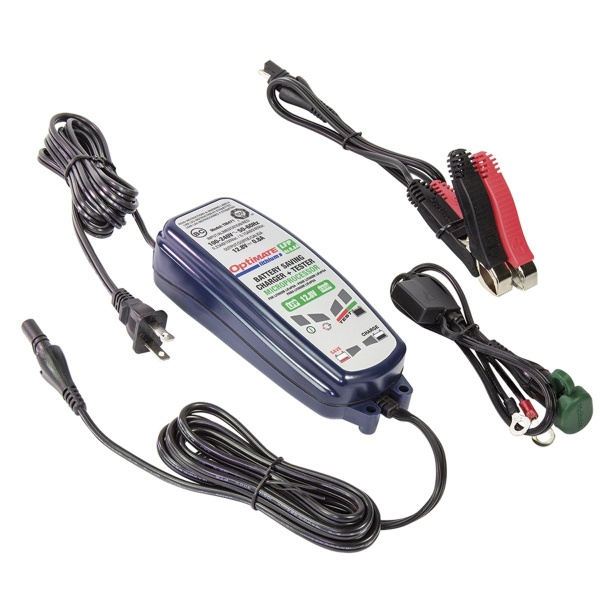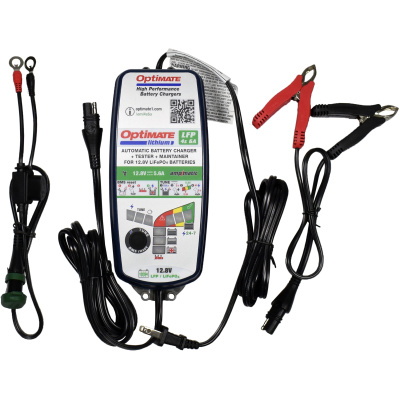Everything You Need to Know About Charging a Motorcycle Battery
You are all set to go for a ride this weekend, but you’ve somehow allowed your motorcycle or ATV battery to become discharged. What can you do? What should you not do? The following are a few dos-and don’ts when you charge a motorcycle battery and are ready to ride. To find the answer to your specific dilemma, it’s good to begin by asking a few basic questions.
- How can I charge my motorcycle battery at home?
- How do you charge a dead motorcycle battery?
- Can you jumpstart a motorcycle with a car?
- Why does my motorcycle battery crank so slow?
- Should I charge my mtorcycle battery on a 2-amp or 10-amp setting?
- How long does it take to charge a motorcycle battery?
How can I charge my motorcycle battery at home?
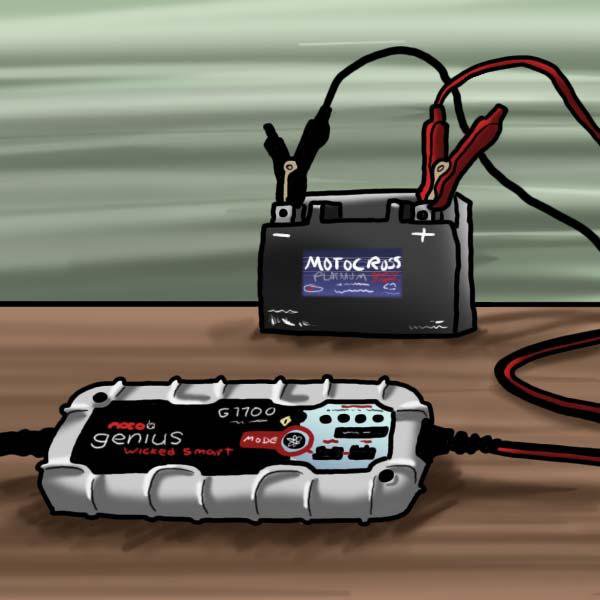
The best answer here is via a good smart charger or battery maintainer. This is an essential tool that every motorcycle owner should have in his garage (along with a multimeter). Not only will it recharge a discharged battery, but it will prevent the battery from getting discharged in the first place when it is used according to manufacturer instructions.
Most motorcycles are a 12v system, so if you are wondering, “Can I use a 12-volt charger on a motorcycle battery?” The answer is yes; 12 volts is the correct voltage for virtually all modern motorcycles. Still, using an appropriately sized charger regarding voltage and amperage is essential. When in doubt, we have a few recommendations below. Or, look at our motorcycle charger section or contact us for recommendations.
Battery Tender Junior 12v 750 mA Smart Charger & Maintainer
- Part# 021-0123
- 4-Stage Smart Charger & Maintainer
- Suitable for Flooded, AGM, or Gel Batteries
- Ideal for 20 AH or Smaller Motorcycle Batteries
BatteryMINDer Plus 12v 1.5 Amp Smart Charger Maintainer & Desulfator
- Part# 1510
- 4-Stage Smart Charger, Maintainer & Desulfator
- Suitable for flooded, Maintenance-Free Sealed, AGM and Gel Batteries.
- Desulfates to increase lifespan up to 4x a normal lifespan!
- Ideal for small and large Powersport Batteries
- 10-Year Warranty!
How do you charge a dead motorcycle battery?
This may seem like the same question as the first, but perhaps what you need to know is, “Can you charge a motorcycle battery with a “regular” charger?” Like an automotive-sized charger? The answer here is a careful yes, no, maybe:
- Yes, you can if the charger has a low amp setting with fewer than about 3-5 amps.
- No, if you only have a bulk charger with a current higher than your battery recommends because it can damage the motorcycle battery.
- Maybe, if you only use a bulk charger for a very short time. Many motorcycle batteries have a quick-charge method labeled on the battery, but this is for urgent situations only! On the batteries we sell, the charging amperage ranges from as little as three amps to 30 amps depending on the size of the battery. The manufacturer allows these higher amp charges only briefly, depending on the battery. This is just enough time to add some energy back into the battery to start your bike and let the charging system on the motorcycle take over, or enough to allow a smart charger to kick on and continue replacing lost charge.
Can you jumpstart a motorcycle with a car?
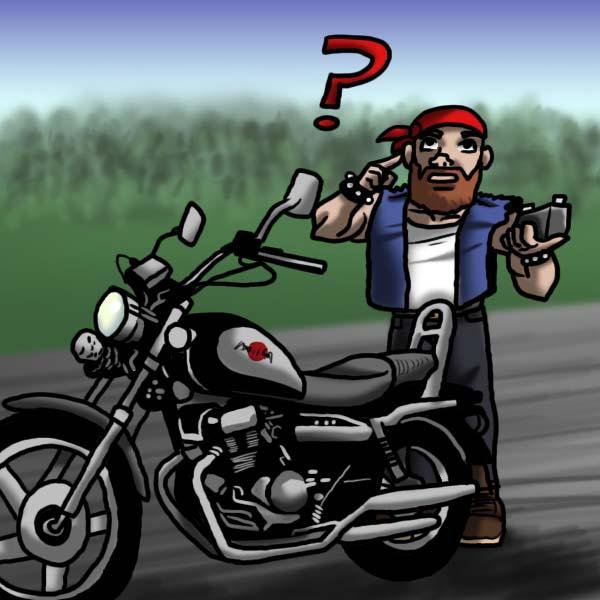
Motorcycle and battery manufacturers will tell you that this is not advised, which is sound advice for the most part. A car charging system is way more powerful than a motorcycle and has way too much current for a motorcycle battery to absorb properly.
Can you ‘get away’ with it in an emergency? While not advised, there are methods to make this a bit less dreadful, but be careful! It is best to disconnect the battery first from the motorcycle, then only jump to your car WITHOUT THE CAR ENGINE RUNNING! Leave connected for only a few minutes at a time, testing the battery voltage often before attempting to reconnect and complete a start.
The lithium Exception
Jumpstarting these is against all lithium battery manufacturer recommendations. Lithium Batteries should not be jumped as they do not take kindly to being fed lots of amperage when excessively discharged. We recommend a smart lithium charger with a safe recovery feature if your lithium battery is discharged.
OptiMATE Lithium 4s 12v 0.8 Amp 8-Step Smart Charger
- Part# TM-471
- Designed for Powersport Lithium Batteries
- Safe Mode to Recover Deeply Discharged Batteries
- Lithium Specific Profile
OptiMATE Lithium 4s 6A | 12.8v 10-Step Lithium Smart Charger
- Part# TM-391
- Ideal for 4-Cell Lithium LFP/LiFePO4 3-72 AH Batteries
- Lithium Specific Profile
- Has a Save Mode for low voltage batteries
- Ideal for small and large Powersport Batteries
Why does my motorcycle battery crank so slow?
Typically, a battery cranks slowly because it is not fully charged. A battery that is not fully charged does not store enough energy to crank a motorcycle engine quickly. One of the most common things riders want to know once they discover a slow-cranking battery is, “Will idling my motorcycle charge the battery?”. The short answer is NO. A motorcycle charging system is designed to put out full charge only when well above idle, and an idling motorcycle can use more power than it produces.
But I am in a hurry. Should I charge my motorcycle battery on a 2 amp or 10 amp setting?
This depends entirely on the battery manufacturer's recommendations. If you don’t have their instructions, the best, safest position to take is slow (lower) is better. Larger batteries are generally more tolerant to higher amps than smaller batteries. But again, if you don’t have the specifications, always err on the side of caution.
So then, how long does it take to charge a motorcycle battery?

Charge time depends on the depth of discharge, the battery's size, and the charger's amp setting. It is recommended to charge slower rather than faster, so generally expect to plan for a minimum of a couple of hours and as much as 24hrs for a full, complete charge when using a motorcycle charger.
So, that’s it then. There are a few methods to charge or recharge your motorcycle battery. With this knowledge, you should be able to get your motorcycle battery charged and ready for the next adventure. Remember, if you have any questions reach out to a battery expert who should be able to fill any knowledge gaps you have. Better to be safe than sorry!



